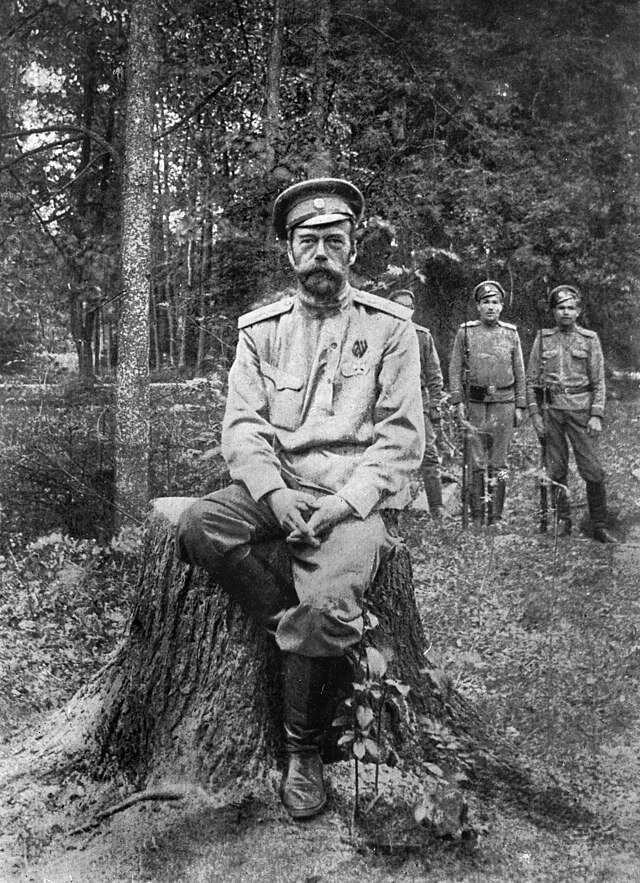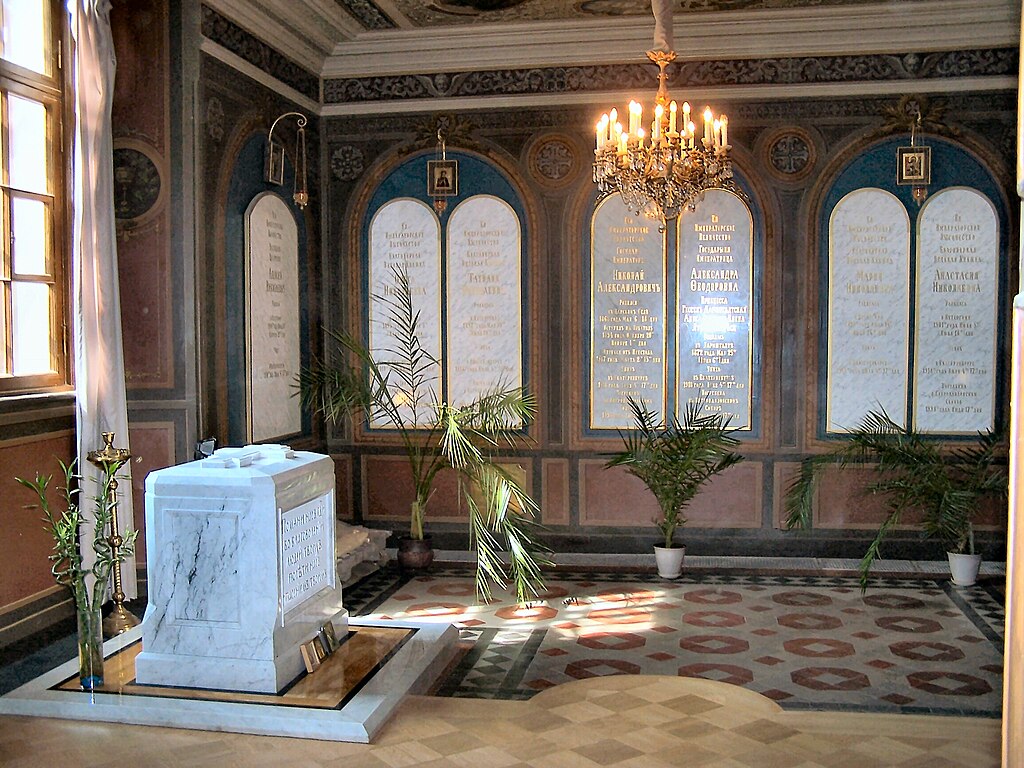by Scott Mehl © Unofficial Royalty 2015

source: Wikipedia
- Unofficial Royalty: Russian Titles and Patronymics
- Unofficial Royalty: First Cousins: Nicholas II, Emperor of All Russia
Nicholas II, Emperor of All Russia was born May 18, 1868, at the Alexander Palace at Tsarskoye Selo, Russia. He was the eldest son of Alexander III, Emperor of All Russia and Empress Maria Feodorovna (born Princess Dagmar of Denmark). At the time of his birth, he was second in line to the Russian throne, following his father. He had five younger siblings:
- Grand Duke Alexander Alexandrovich (1869 – 1870), died young of meningitis
- Grand Duke George Alexandrovich (1871 – 1899), unmarried, died of tuberculosis
- Grand Duchess Xenia Alexandrovna (1875 – 1960), married Grand Duke Alexander Mikhailovich of Russia, had seven children
- Grand Duke Michael Alexandrovich (1878 – 1918), married Natalia Sergeyevna Sheremetyevskaya, Countess Brasova, had one child
- Grand Duchess Olga Alexandrovna (1882 – 1960), married (1) Peter Friedrich Georg, Duke of Oldenburg, no children; (2) Nikolai Kulikovsky, had two children
Nicholas was raised with his brother George who was three years younger. They were raised in a relatively simple manner considering their status. George and Nicholas slept in cots, woke up at 6:00 AM, took cold baths, and ate simple, plain meals. Their rooms were furnished with simple furniture. Both brothers were fluent in Russian, English, French, German, and Danish. The boys enjoyed shooting and fly fishing with their English tutor.
The Imperial Family always attended the graduation performances of the Imperial Ballet School and so in the audience in 1890 was Alexander III, Emperor of All Russia and his family including his son and heir the future Nicholas II, Emperor of All Russia. The Imperial Family watched as graduating student Mathilde Kschessinskaya performed a pas de deux from La Fille Mal Gardée with a male graduating student. Afterward, the graduates were presented to the Imperial Family and Emperor Alexander III told Mathilde told her to “be the glory and adornment of our ballet.” At the post-performance supper, Emperor Alexander III insisted that Mathilde sit next to him and then motioned his son and heir Tsesarevich Nicholas Alexandrovich to sit on her other side – and so the seventeen-year-old Mathilde met the twenty-two-year-old Nicholas for the first time.

Mathilde Kschessinskaya; Credit – Wikipedia
According to Mathilde’s later recollections, she had a relationship with Nicholas from 1890 – 1894. To facilitate their meetings, the imperial court rented a villa in St. Petersburg. The relationship ended when Nicholas became engaged to Princess Alix of Hesse and by Rhine in April 1894. Mathilde was generously compensated with the villa that had served as their meeting place and a sum of money. Nicholas II never met her in private after that, but he often watched her performances and always supported her discreetly whenever she needed it.
In 1884, having recently come of age, Nicholas attended the wedding of his uncle Grand Duke Sergei Alexandrovich to Princess Elisabeth of Hesse and by Rhine. It was here that he first met the bride’s younger sister, Princess Alix. The two were second cousins through their mutual great-grandparents, Ludwig II, Grand Duke of Hesse and by Rhine and his wife Wilhelmine of Baden. It would be five years later, while Alix was visiting her sister in Russia, that the two would fall in love.
The prospect of marriage was met with much opposition from both Nicholas’ parents and Alix’s grandmother Queen Victoria. The Emperor and Empress felt that Alix was not suitable enough for their son, in part because of their dislike and distrust for all things German. They also hoped for a ‘higher profile’ bride and future Empress. As for Queen Victoria, she quite liked Nicholas personally. However, the same could not be said for his father, or for Russia itself. She also felt uneasy about another of her granddaughters marrying into the Russian Imperial Family. Queen Victoria had promoted marriage between Alix and her first cousin Prince Albert Victor of Wales, but Alix showed no interest. However, she was quite fond of her granddaughter and eventually gave into Alix’s wishes.

source: Wikipedia
Despite the misgivings of their respective families, the couple became engaged in April 1894, while in Coburg, Duchy of Saxe-Coburg and Gotha attending the wedding of Alix’s brother. Nicholas was representing his father at the wedding of Alix’s brother Grand Duke Ernst Ludwig of Hesse and by Rhine to Princess Victoria Melita of Edinburgh and Saxe-Coburg and Gotha, Alix and Nicholas’ mutual first cousin. At first, Alix refused his proposal, as she was a devout Lutheran and was unwilling to convert to Russian Orthodoxy as would be required. However, after some urging from her elder sister who had married into the Romanov family, Alix relented and accepted. The wedding was planned for the spring of 1895.
Sadly, in the fall of 1894, Nicholas’ father fell ill. Sensing that there was not much time left, Alexander III instructed Nicholas to send for Alix, who arrived on October 22nd. Despite his ailing health, Alexander III insisted on greeting her in full uniform and gave her his blessing. Alexander III died just ten days later, leaving the 26-year-old Nicholas as the new Emperor of All Russia. The following day, Alix was received into the Orthodox Church, taking the name Grand Duchess Alexandra Feodorovna. Nicholas initially wanted to marry immediately, even before his father’s funeral, in a private ceremony. However, he was convinced that as Emperor, he should marry in St. Petersburg with at least some of the pomp and ceremony that was traditional in the Russian Imperial Family.

The wedding of Nicholas and Alexandra, painting by Laurits Tuxen. Source: Wikipedia
It was on November 26, 1894, in the Grand Church of the Winter Palace, that Nicholas and Alix were married in a traditional Orthodox ceremony. Because of the formal mourning for his father, the couple did not take a honeymoon and took up residence temporarily at the Anichkov Palace with his mother. They would soon move to the Alexander Palace, which would be their primary home for the remainder of their lives. Over the next ten years, the couple had five children:
- Grand Duchess Olga Nikolaevna (1895-1918)
- Grand Duchess TatianaNikolaevna (1897-1918)
- Grand Duchess Maria Nikolaevna (1899-1918)
- Grand Duchess Anastasia Nikolaevna (1901-1918)
- Tsesarevich Alexei Nikolaevich (1904-1918)

Coronation of Nicholas II; Credit – Wikipedia
On May 14, 1896, Nicholas’ coronation was held in the Uspensky Cathedral in the Kremlin. The following day, a large celebration was held in the Khodynka Field outside of Moscow. Tragically, over 1,300 people were killed, and another 1,300 were injured when the crowds surged forward toward the food and drinks which were being given out. That evening, Nicholas was scheduled to attend an event hosted by the French ambassador, which he intended to cancel after the tragedy. But, told that it would be a huge snub to the host, and to relations with France, he relented and attended. This made him appear indifferent to the suffering of his people. The whole affair would be the first of many events which contributed to the distrust and outright hatred of many of the Russian people toward their Emperor.

Russian Imperial family (circa 1913-1914); Photo Credit – Wikipedia
Nicholas’ reign would see the first Russian Constitution of 1906 which established a parliament of sorts. His reign also saw a steady decline in his popularity and support. His decision to fully mobilize the Russian troops in 1914 led to Russia’s entrance into World War I. By 1917, his authority had diminished, and on March 15, 1917, he was forced from the throne. He formally abdicated for himself and his son, making his younger brother, Mikhail, the new Emperor. Mikhail, however, refused to accept until the Russian people could decide on continuing the monarchy or establishing a republic.

Nicholas at Tsarskoye Selo after his abdication, 1917. source: Wikipedia
The former Emperor returned to the Alexander Palace where he and his family were held in protective custody. A few months later, in August, the family along with 45 retainers were moved to the city of Tobolsk, where they lived in the Governor’s Mansion, still under heavy guard. Their final move, in April 1918, was to Yekaterinburg where they were housed in the Ipatiev House – known as the ‘house of special purpose’. It was here, in the early hours of July 17, 1918, that Nicholas, his wife and children, and the few retainers who had remained with them, were killed by the Bolsheviks. Their bodies were initially thrown down a mine, but fearing discovery, they were mutilated and hastily buried beneath some tracks. For more information see July 17, 1918 – Execution of Nicholas II, Emperor of All Russia and His Family
For many years, several members of the Imperial Family (including Nicholas’ mother) refused to believe the stories of their deaths. Other members of the family had been killed, and their bodies had been found and identified. But Nicholas’ and his family’s remains were never found, prompting numerous pretenders to come forward claiming to be one of the Grand Duchesses or the Tsarevich.
Finally, in 1979, a mass grave was discovered, believed to include the remains of the Imperial Family. The bodies were exhumed in 1991, and in 1998, through DNA testing, it was formally announced that the remains were of Nicholas, Alexandra, and three of their daughters. On July 17, 1998 – 80 years to the day of their murders – the bodies were interred in St. Catherine Chapel at the Peter and Paul Cathedral in St. Petersburg. The remains of the last two children, Alexei and Marie were found in a nearby grave in 2007 and positively identified the following year. However, their remains have not yet been buried. The Russian Orthodox Church has questioned whether the remains are authentic and blocked the burial.

St. Catherine Chapel at the Peter and Paul Cathedral where the Imperial Family is interred; source: Wikipedia
This article is the intellectual property of Unofficial Royalty and is NOT TO BE COPIED, EDITED, OR POSTED IN ANY FORM ON ANOTHER WEBSITE under any circumstances. It is permissible to use a link that directs to Unofficial Royalty.
Romanov Resources at Unofficial Royalty
